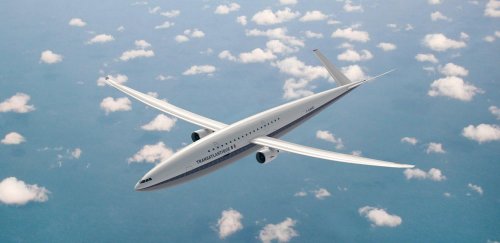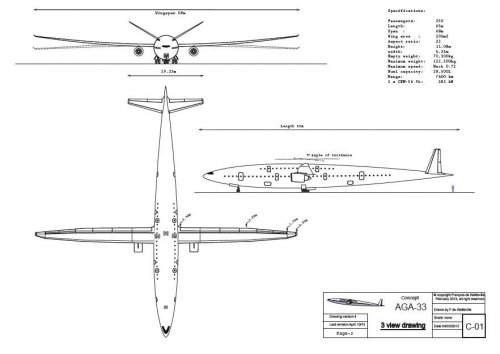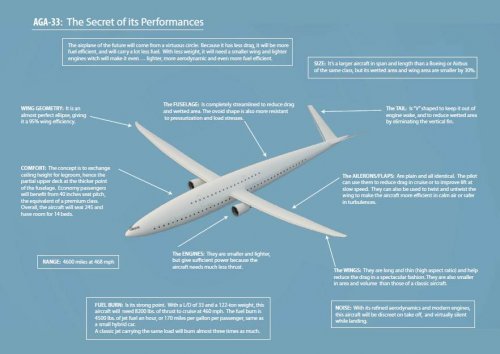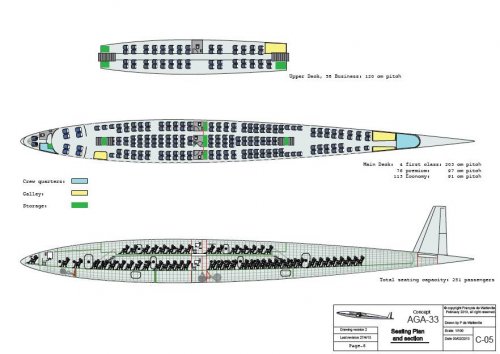- Joined
- 25 June 2009
- Messages
- 14,759
- Reaction score
- 6,167
Industrial designer Francois de Watteville has produced a concept for a fuel-efficient long-haul airliner that uses conventional structures and stock engines and instead focuses on seeing how far fuel economy can be improved by refining the aerodynamics.
De Watteville's resulting 250-passenger AGA-33 concept has been brought to life by Henry Lam of Kaktus Digital (who created the future airliner concept that graced the cover of the June 20, 2011, Paris air show issue of Aviation Week & Space Technology).
The project “started out of pure curiosity and became an obsession” to determine what an aircraft of the future would look like, says de Watteville. The design “assignment” was to use know materials (aluminum, composites and steel), technologies and engines (CFM56s) and focus on shape and performance in pursuit of fuel economy.
The main idea, he says, was to boost lift-to-drag ratio (L/D) by increasing wing span while reducing wetted area. Here are the main design features as outlined by de Watteville:
Fuselage – is completely symmetrical to simplify construction, improve aerodynamics and reduce wetted area.
Double deck – wrings as much floor area as possible out of the fuselage shape and concentrates weight where the structure is stronger and wider.
Straight wing – fuel efficiency dictates a slender wing for low drag, but this limits speed to Mach 0.72, adding an hour to a transatlantic crossing – “not too bad”, he says, when total trip time is considered.
Plain flaps – with such a long span, plain flaps provide a landing speed under 130kt at a lift coefficient of only 1.8. Negative flap settings can reduce drag or control wing twist. No slats.
Underwing engines – conventionally located for structural reasons (wing bending relief) and easy maintenance access.
V-tail – chosen to keep the tail out of the engine exhaust, lighter than a T-tail – and more “elegant”, de Watteville considers.
Here’s how de Watteville says the AGA-33 compares with the Boeing 787-8 (figures in brackets). The fuselage is 65m (57m) long and 6.25m (5.7m) wide at its maximum. Wing span is 68m (60m) and area 206m² (325m²). Total wetted area is 1,380m² (1,820m²). Lift-to-drag ratio is 32 (20). Engines are a pair of 31,000lb-thrust CFM56s (two 64,000lb-thrust GEnx or Trent 1000s)
Maximum take-off weight for a 6,000km maximum-payload mission is 122 metric tons (787: 199t), empty weight is 70t (110t), fuel load 20t (44t), total passenger and cargo payload is 31t (45t). Putting the price of an AGA-33 at $100 million versus $114 million for a 787, de Watteville estimates a profit per transatlantic trip of $18,374 versus $11,223 for the Boeing.
It’s a design exercise, so it’s not worth getting too worked up over the comparisons. It’s the design choices that are interesting, and what results if you pursue aerodynamics over other factors. My colleague Guy Norris says the AGA-33 resembles a blend of the Breguet Sahara and Hurel-Dubois HD-31. I have to agree with him – it just looks French.
While the high L/D would reduce the size of engines needed to climb and cruise, and so improve fuel economy, I am not convinced a pair of CFM56s would be powerful enough to provide the single-engine takeoff performance required.
In De Watteville's own words: « This concept is about advancing the idea of fuel-economy "as far as we can, with what we have".
There is no question in my mind that the sales success of the 787 and 350 are 95% due to fuel economy; No airline will want to be left behind competing without these new planes. Prepare to see aircrafts with longer wings and more slender fuselages at each new design upgrade.
The AGA airframe is interesting because it is about as far as one can go, and it places a value on a "practical" best L/D. Witch is about 30-34. To go higher one would have to run into serious structural and practical problems. »
Source: AW&ST's "Things with Wings — The Commercial Aviation Blog"
(thanks a lot to Flateric for bringing this project to my attention!)
De Watteville's resulting 250-passenger AGA-33 concept has been brought to life by Henry Lam of Kaktus Digital (who created the future airliner concept that graced the cover of the June 20, 2011, Paris air show issue of Aviation Week & Space Technology).
The project “started out of pure curiosity and became an obsession” to determine what an aircraft of the future would look like, says de Watteville. The design “assignment” was to use know materials (aluminum, composites and steel), technologies and engines (CFM56s) and focus on shape and performance in pursuit of fuel economy.
The main idea, he says, was to boost lift-to-drag ratio (L/D) by increasing wing span while reducing wetted area. Here are the main design features as outlined by de Watteville:
Fuselage – is completely symmetrical to simplify construction, improve aerodynamics and reduce wetted area.
Double deck – wrings as much floor area as possible out of the fuselage shape and concentrates weight where the structure is stronger and wider.
Straight wing – fuel efficiency dictates a slender wing for low drag, but this limits speed to Mach 0.72, adding an hour to a transatlantic crossing – “not too bad”, he says, when total trip time is considered.
Plain flaps – with such a long span, plain flaps provide a landing speed under 130kt at a lift coefficient of only 1.8. Negative flap settings can reduce drag or control wing twist. No slats.
Underwing engines – conventionally located for structural reasons (wing bending relief) and easy maintenance access.
V-tail – chosen to keep the tail out of the engine exhaust, lighter than a T-tail – and more “elegant”, de Watteville considers.
Here’s how de Watteville says the AGA-33 compares with the Boeing 787-8 (figures in brackets). The fuselage is 65m (57m) long and 6.25m (5.7m) wide at its maximum. Wing span is 68m (60m) and area 206m² (325m²). Total wetted area is 1,380m² (1,820m²). Lift-to-drag ratio is 32 (20). Engines are a pair of 31,000lb-thrust CFM56s (two 64,000lb-thrust GEnx or Trent 1000s)
Maximum take-off weight for a 6,000km maximum-payload mission is 122 metric tons (787: 199t), empty weight is 70t (110t), fuel load 20t (44t), total passenger and cargo payload is 31t (45t). Putting the price of an AGA-33 at $100 million versus $114 million for a 787, de Watteville estimates a profit per transatlantic trip of $18,374 versus $11,223 for the Boeing.
It’s a design exercise, so it’s not worth getting too worked up over the comparisons. It’s the design choices that are interesting, and what results if you pursue aerodynamics over other factors. My colleague Guy Norris says the AGA-33 resembles a blend of the Breguet Sahara and Hurel-Dubois HD-31. I have to agree with him – it just looks French.
While the high L/D would reduce the size of engines needed to climb and cruise, and so improve fuel economy, I am not convinced a pair of CFM56s would be powerful enough to provide the single-engine takeoff performance required.
In De Watteville's own words: « This concept is about advancing the idea of fuel-economy "as far as we can, with what we have".
There is no question in my mind that the sales success of the 787 and 350 are 95% due to fuel economy; No airline will want to be left behind competing without these new planes. Prepare to see aircrafts with longer wings and more slender fuselages at each new design upgrade.
The AGA airframe is interesting because it is about as far as one can go, and it places a value on a "practical" best L/D. Witch is about 30-34. To go higher one would have to run into serious structural and practical problems. »
Source: AW&ST's "Things with Wings — The Commercial Aviation Blog"
(thanks a lot to Flateric for bringing this project to my attention!)




